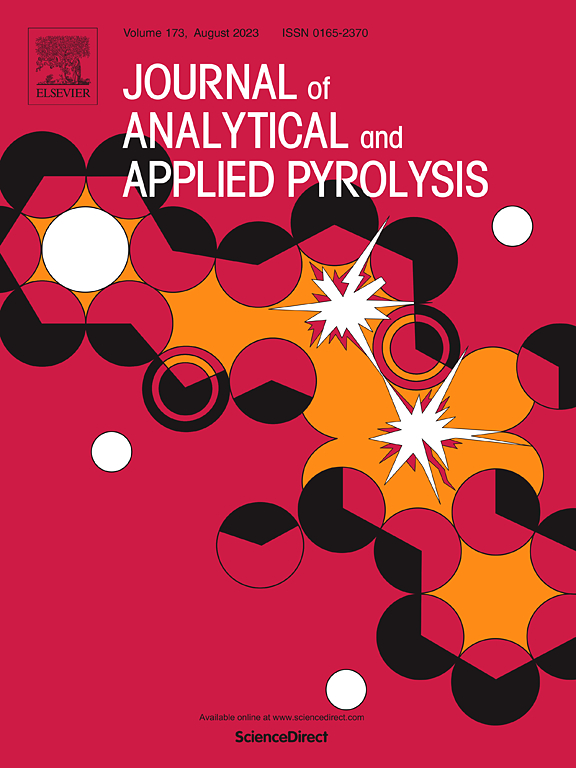Research on modeling the lignin waste molecular structure and pyrolytic reactions using ReaxFF MD method
IF 5.8
2区 化学
Q1 CHEMISTRY, ANALYTICAL
引用次数: 0
Abstract
The lack of clarity in characterizing the chemical structure model of lignin waste hinders the comprehensive understanding of its pyrolysis reaction mechanism. The characterization results revealed that the de–alkalized lignin sample contained larger amounts of aliphatic and aromatic carbons compared to carbonyl carbons. Additionally, the aliphatic carbon molecules exhibited a higher presence of oxygenated carbons. The degree of aromaticity (fa) was determined to be 63.93 %. The resulting single–molecule structural model exhibited a molecular formula of C33H26O11 and a molecular weight of 598.56. Furthermore, the evolutions patterns and formation pathways of primary volatile components (H2, CH4, CO, and CO2) in pyrolysis reactions were revealed. The number of H2 molecules exhibited a positive correlation with the rise in pyrolysis reaction temperature. CH4 molecules exhibited a pattern of initially increasing and subsequently decreasing. The number of CO molecules exhibited a positive correlation with the rise in pyrolysis temperature. Conversely, the number of CO2 molecules demonstrated an initial increase followed by a decrease as the pyrolysis temperature increased. Finally, the generation pathway analysis of pyrolysis products shows that the H2 molecule is composed of two hydrogen atoms bonded together that have been dissociated from the carboxyl group. Alternatively, it can be produced through hydrogenation reactions involving hydrogen atoms detached from the carboxyl group and methyl groups. CH4 is primarily generated through the reaction between –CH3 and free hydrogen ions. CO is primarily produced through the cleavage of the carbonyl group. CO2 is primarily produced through the cleavage of carboxyl and ester groups.
利用 ReaxFF MD 方法建立木质素废料分子结构和热解反应模型的研究
木质素废料化学结构模型的表征不清晰,阻碍了对其热解反应机理的全面了解。表征结果显示,与羰基碳相比,脱醛木质素样品含有更多的脂肪族碳和芳香族碳。此外,脂肪族碳分子中还含有较多的含氧碳。芳香度 (fa) 被测定为 63.93%。由此得到的单分子结构模型的分子式为 C33H26O11,分子量为 598.56。此外,还揭示了热解反应中主要挥发性成分(H2、CH4、CO 和 CO2)的演变规律和形成途径。H2 分子的数量与热解反应温度的升高呈正相关。CH4 分子呈现出先增加后减少的模式。CO 分子的数量与热解温度的升高呈正相关。相反,随着热解温度的升高,CO2 分子的数量表现出先增加后减少的规律。最后,热解产物的生成途径分析表明,H2 分子是由两个与羧基分离的氢原子结合而成的。另外,它也可以通过氢原子与羧基和甲基发生氢化反应生成。CH4 主要通过-CH3 和游离氢离子的反应生成。CO 主要通过羰基的裂解生成。CO2 主要通过羧基和酯基的裂解生成。
本文章由计算机程序翻译,如有差异,请以英文原文为准。
求助全文
约1分钟内获得全文
求助全文
来源期刊
CiteScore
9.10
自引率
11.70%
发文量
340
审稿时长
44 days
期刊介绍:
The Journal of Analytical and Applied Pyrolysis (JAAP) is devoted to the publication of papers dealing with innovative applications of pyrolysis processes, the characterization of products related to pyrolysis reactions, and investigations of reaction mechanism. To be considered by JAAP, a manuscript should present significant progress in these topics. The novelty must be satisfactorily argued in the cover letter. A manuscript with a cover letter to the editor not addressing the novelty is likely to be rejected without review.

 求助内容:
求助内容: 应助结果提醒方式:
应助结果提醒方式:


